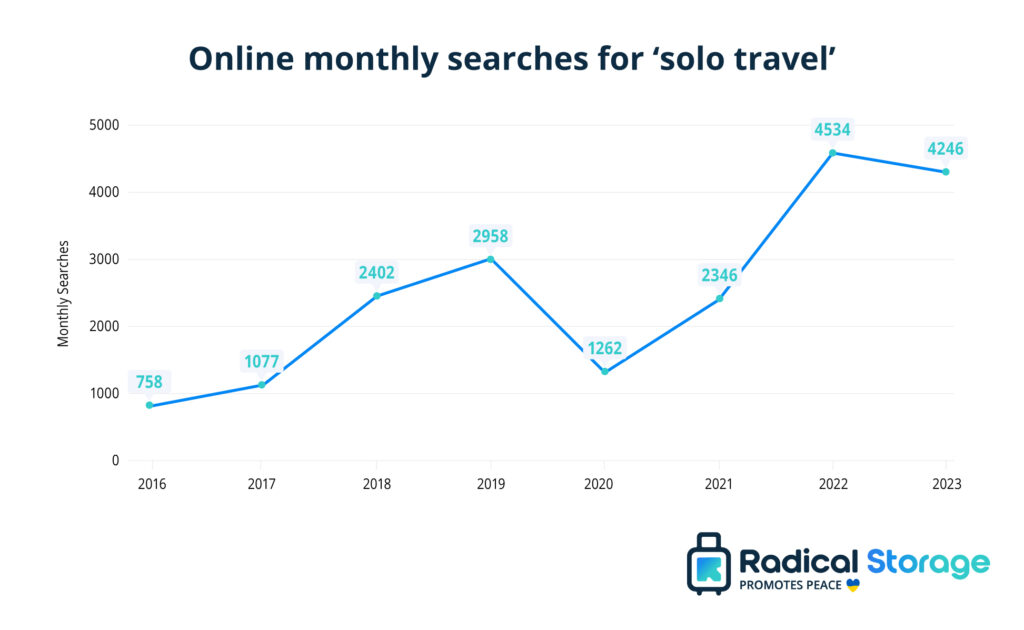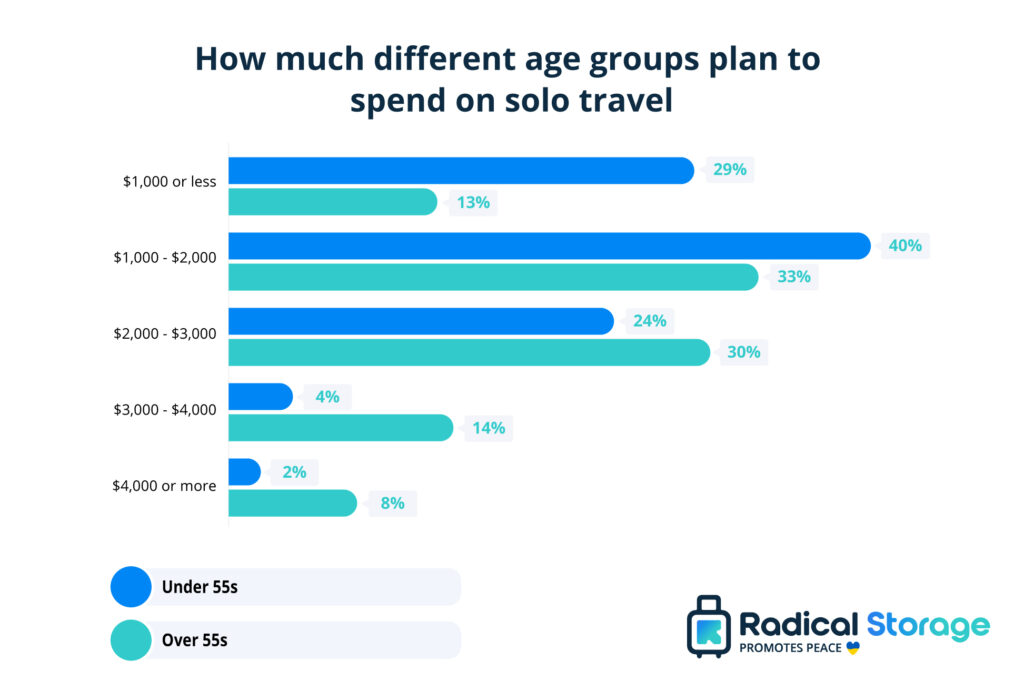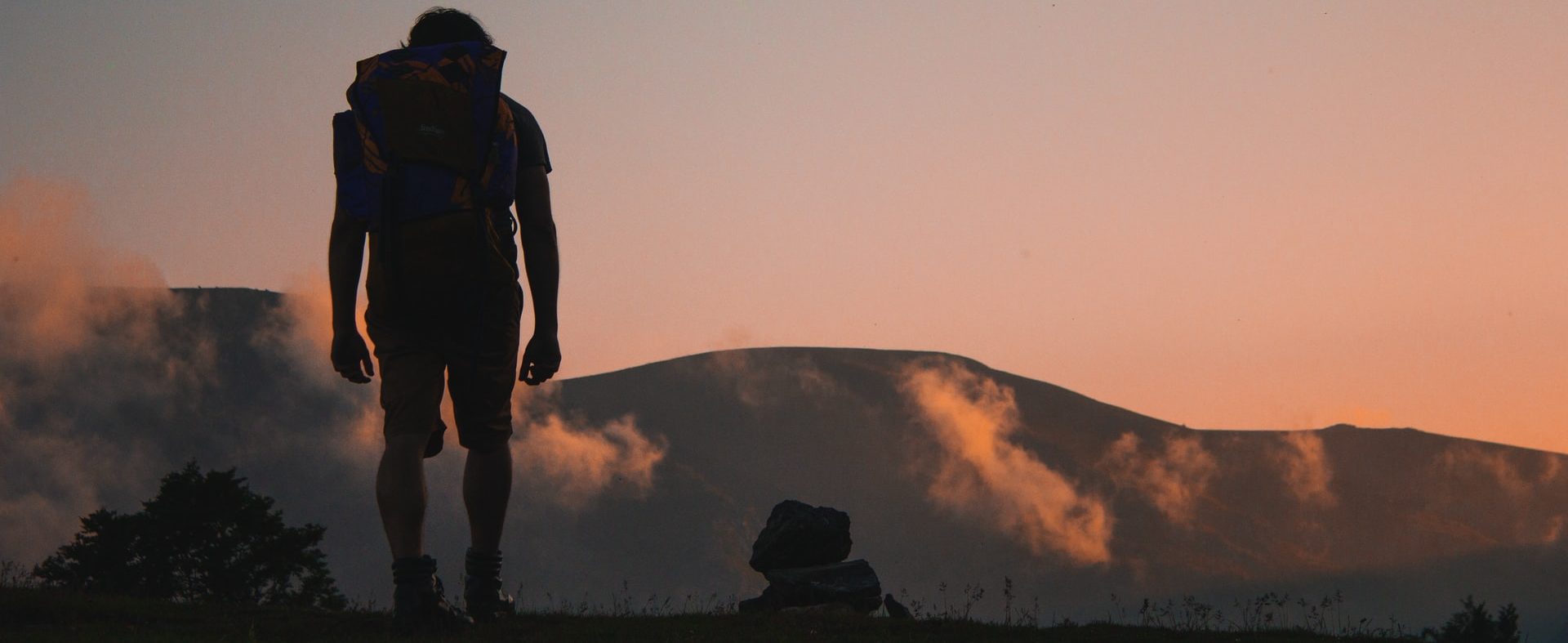Solo travel is becoming more popular in the tourism industry with a growing number of people choosing to travel the world alone rather than with friends or a partner. But how popular is traveling alone? And what are some of the top places to visit?
We’ve looked into some of the most interesting solo travel statistics, including female solo travel stats, to see how many people are traveling alone, where they go, and how much they spend.
Key Statistics
- 46% of women said that concerns about their safety are the main thing that would stop them from solo traveling.
- Men said their biggest worry about solo traveling was the cost of the trip compared to traveling with another person.
- Online searches for the term ‘solo travel’ increased by 236% from April 2020 to April 2023.
- Over 50% of nights booked on Airbnb during one three-month period were for solo travelers.
- The most popular destination for solo travel is Australia, with 71% of people who travel alone saying they have visited this country at least once.
- In the U.S. 16% of people have taken a vacation by themselves, and 25% said they were thinking of taking a solo trip in the future.
- A person traveling alone pays an average of 47% more than someone traveling as part of a couple.
- Pre-pandemic, 14% of people said they would consider traveling alone, but that figure has now increased to 23%, an 85% increase overall.
- 72% of American women are now planning to go on solo trips instead of traveling with a partner or friends.
- A rough cost for a round-the-world trip for one person a year is $20,000 USD (£16,309.90 GBP).
Global leisure travel statistics
The global leisure travel market was valued at $1,006.5 billion in 2019, and researchers project it to reach $1,737.3 billion by 2027, creating a Compound Annual Growth Rate (CAGR) of 22.6% from 2021 to 2027. This market is split into two segments: solo travelers and group travelers. Group travelers hold a major share of the market, but solo travelers are expected to see growth at the highest CAGR during the next forecast period.[1]
The significant increase in people wanting to go solo traveling has encouraged companies in the industry to improve their offering of single-person holidays and trips, rather than catering mainly to groups.
Online searches for solo travel
Online searches for terms including ‘solo travel’ have increased by more than 236% since April 2020, indicating that more people are taking an interest in this type of travel.
Back in April 2016, the monthly search volume in the U.S. for ‘solo travel’ was 758, this increased by 290% to 2,958 in 2019. Searches for this keyword dropped in 2020 due to the COVID-19 pandemic putting limits on travel, but they rose back up to 4,534 in 2022, and have reduced slightly to 4,246 in April 2023. This is an overall increase of 460% since 2016.
| Month, Year | US monthly searches | YoY % Change |
| April 2016 | 758 | – |
| April 2017 | 1,077 | +42% |
| April 2018 | 2,402 | +123% |
| April 2019 | 2,958 | +23% |
| April 2020 | 1,262 | -57% |
| April 2021 | 2,346 | +86% |
| April 2022 | 4,534 | +93% |
| April 2023 | 4,246 | -6% |

How many people solo travel?
In the United States, 16% of people have taken a vacation by themselves, and 25% said they were thinking of taking a solo trip in the future. Based on 2022 population figures, this means an estimated 41 million American adults have taken a solo vacation already, and a further 65.2 million are planning to do so.[2]
Other reports produced similar figures, with pre-pandemic data showing that only 14% of people would consider traveling alone, but that figure has now increased to 23% who say they would be planning to take a solo trip in the future.[3]
Solo travelers by demographic
Around a quarter of people in the U.S. who were planning to go on a trip alone were from the Generation X age group (born between 1965 and 1980), and the average age of all solo travelers is 47.[4]
Over half (58%) of millennials say they have traveled alone, compared to 47% of people in older generations. The majority (86%) of people who travel solo are over 35 years of age.
The U.S. had the lowest number of women who had been on a solo trip at just 17%, whereas 46% of men in the U.S. had traveled alone. However, findings did show that women who had traveled alone were more likely to have traveled for 6 months or more.
Interest in solo travel by generation
Data also showed that Gen Z was the generation most likely to have an interest in solo travel, with 76%, and millennials were the least likely to be interested in traveling alone, at 58%.
Gen X (73%) and Baby Boomers (71%) came closely in second and third place, with many perhaps wanting to use their retirement to explore alone and visit new places.
Source[4]
Accommodation stats for single travelers
When it comes to traveling by yourself, accommodation is one of the biggest costs you’re likely to incur. A UK-based study found that, of those who had been on a solo trip, 65% had stayed in hotels, 44% had stayed at an Airbnb property, and 18% had stayed in hostels.
Source[5]
Almost three-quarters (74%) of individuals who used Airbnb said they did so to avoid additional charges associated with hotels. Of those who stayed in hostels, 35% said that the communal aspect appealed to them the most, whereas 29% said that they had only used them because of the cheaper costs compared to other options.
Airbnb solo travel statistics
Data from Airbnb shows that 26% of all nights booked on their platform in 2021 were from solo travelers. They also found that over 50% of the nights booked in the first quarter of 2022 for long-term stays were for people traveling solo.[6]
The considerable proportion of Airbnb customers using their platform for solo accommodation bookings encouraged the company to add new safety features to their app, initially for English-speaking guests. This includes the ability to share their reservation itinerary with a trusted person, get tips for traveling safely in the local area, and get suggestion questions to ask their host during their stay.
As safety is sometimes a concern for people traveling by themselves, this feature could help travelers feel more comfortable booking a solo trip that they’ve been thinking about.
Where do people solo travel to?
Australia is considered the most popular destination for individuals, with 71% of solo travelers saying they have visited the country. Australia is generally considered a safe place to travel alone, and it has plenty of diverse areas and cities to visit. The country also offers a wide variety of group tours to some of the key visitor locations.
Cities solo travelers are interested in
We mentioned earlier that online searches relating to solo travel had increased over the past few years, and particularly since the COVID-19 pandemic. Let’s take a look at which destinations Google users in the U.S. are searching for when it comes to solo traveling.
Data from Google search volumes in 2023 shows that the general term ‘best places to solo travel’ had a search volume of 2,900 in the U.S. When it came to specific locations, ‘solo travel USA’ was the most popular search with a monthly average volume of 1,300, though this was down by 23% compared to 2022. This was followed by Italy with 720 monthly searches.
The country with the highest YoY increase in searches by U.S. solo travelers was Germany, with ‘solo travel Brazil’ seeing a 125% increase in searches from 2022 to 2023.
| Search Term | U.S. Monthly Searches | YoY % Change |
| Best places to solo travel | 2,900 | 0% |
| Solo travel USA | 1,300 | -23% |
| Solo travel Italy | 720 | 0% |
| Solo travel Thailand | 590 | 0% |
| Solo travel Mexico | 320 | +23% |
| Solo travel Spain | 320 | -19% |
| Solo travel New Zealand | 260 | 52% |
| Solo travel Australia | 140 | +27% |
| Solo travel Germany | 90 | +80% |
| Solo travel Canada | 90 | 0% |
| Solo travel Brazil | 90 | +125% |
| Solo travel UK | 50 | 0% |
| Solo travel Cambodia | 50 | -64% |
| Solo travel Indonesia | 50 | -22% |
| Solo travel France | 30 | 0% |
Source: Google Keyword Planner, data sourced by Radical Storage in October 2023
The costs of solo traveling
A rough cost for one person traveling alone for a whole year is $20,000, but this can vary depending on where you go, the type of accommodation you choose, transport, and many other factors.
Choosing more luxury destinations or hotels could see the cost rise up to $40,000-$50,000. Traveling as a couple won’t necessarily double the costs as things like accommodation and transport can be a shared cost.
One traveler detailed her expenses for a round-the-world trip that lasted 11 months. This involved travel to 15 countries including Australia, Nepal India, Croatia, Italy, and the UK.
The breakdown of costs includes $3,577.40 for flights, $3,130.77 for lodging, and $2,820.11 for food during the trip. Other expenses of the year-long trip were $606 for vaccines required in certain countries and $230 for visas. You can see the full list of costs for this particular trip in the table below.
| Travel Expense | Cost (USD$) |
| Flights | $3,577.40 |
| Lodging | $3,130.77 |
| Food | $2,820.11 |
| Activities + Entertainment | $3,613.18 |
| Transportation | $1,943.43 |
| Misc (internet, gifts, extra gear, etc) | $1,753.67 |
| Visas | $230 |
| Pre-Trip Travel Gear | $484.50 |
| Vaccines | $606 |
| Extra Costs | $493.33 |
| Total | $18,588.39 |
Source[7]
Staying in hostels, preparing your own food and using more budget transport options can help cut the costs of a long trip if you’re conscious of money when traveling alone.
Monthly solo travel costs in popular vacation destinations
We’ve looked at some popular vacation spots around the world and put together the average cost of a week’s trip for a solo person, not including flights.
| Location | Cost of a Solo Trip for a Week (USD$) |
| Las Vegas, USA | $1,723 |
| New York City, USA | $1,668 |
| Houston, USA | $1,467 |
| Paris, France | $1,353 |
| Los Angeles, USA | $1,342 |
| New Orleans, USA | $1,336 |
| London, UK | $1,249 |
| San Francisco, USA | $1,226 |
| Melbourne, Australia | $1,081 |
| Sydney, Australia | $993 |
| Milan, Italy | $976 |
| Rome, Italy | $966 |
| Mexico City, Mexico | $959 |
| Barcelona, Spain | $907 |
| Berlin, Germany | $808 |
| Cancun, Mexico | $696 |
| Bali, Indonesia | $442 |
| Bangkok, Thailand | $427 |
Source[8]
How much does a solo traveler pay compared to a couple?
A 2023 study analysing package holidays from the UK’s largest package holiday providers, Jet2holidays and Tui, sought to find out how much a solo traveler would pay for a trip compared to two people traveling together.
The data showed that someone traveling solo with Tui would pay, on average, 47% more than someone traveling with another person. The average cost for a person traveling alone came to £1,147, compared with £781 per person for a couple.
What would people spend on solo travel
Most travelers said they would spend between $1,000 and $2,000 per week on a solo trip, excluding the airfare for getting to their destination.
Data shows a difference between the spending of solo travelers over the age of 55 and those under 55. People under 55 were more likely to spend less, with 70% saying they would spend $2,000 or less on a solo trip, compared to 53% of people over 55.
Travelers in the older group were more likely to spend a larger amount of money on their solo trips, with 17% saying they would spend over $3,000, compared to 9% of people in the younger group. Of the over 55s, 6% said they had planned to spend more than $4,000 on traveling by themselves which was twice as much as the under 55s at 3%.

Source[9]
Reasons people choose to travel alone
A survey by British Airways found that solo travelers’ top motivation for traveling alone was to do what they wanted to do, with 76% saying this was their main reason. Alongside this, almost two-thirds (63%) said that they wanted to take time out for themselves, and 37% said they wanted to explore a new location they had not visited before.[11]
Some of the other reasons people said they had traveled alone or wanted to include:
- Choosing the destination, what you eat and what you do (55%)
- Meeting new people and having new experiences (50%)
- Getting over a break-up (10%)
It is often very important for solo travelers to think about everything they need to take on the road, and this results in large, bulky bags.
To avoid wandering around with weights, it can be helpful to find places to store your luggage near some of the main stations, such as:
- Rome: Termini and Tiburtina
- Venice
- Milan, also Porta Garibaldi, Duomo
- Paris: Gare du Nord, Gare de l’Est, Gare de Lyon
- Madrid
- Barcelona, also Plaza de Espana
- Valencia: Nord Station and Joaquin Sorolla
- Amsterdam
- Prague
- Budapest: Keleti and Nyugati
- Dublin
- Edinburgh: Waverley and Haymarket
Why are Americans planning to travel?
In 2021, Americans were asked whether they were planning to travel, and what the reason for their trip was. Over one-fifth (21%) said that they planned to go on a solo trip.
The most popular reason for travel was a vacation, with 87% of people, followed by a business trip (52%), and visiting family and friends (42%). Almost a third (32%) of respondents said that they planned to take a trip that they had rescheduled because of COVID-19.
Source[10]
Female solo travel statistics
Recent data shows that 72% of American women are now choosing to go on solo trips. Online searches for ‘solo female travel’ have increased by 34% since 2019.
The most common reasons women said they would like to go solo traveling were to do something they hadn’t done before (41%) and to have the freedom to do whatever they want (40%).[11]
Let’s take a look at some more female solo travel statistics:
- Flying vs road-trips: Over two-thirds (69%) of women said they would prefer to fly for a solo trip, compared to 57% of men. Men were more likely to take a road trip in their own vehicle with 63% of men saying they planned to do this, as opposed to 43% of women.
- Less camping or cabins: Surveys found that women were almost half as likely as men to stay in a cabin or camp outdoors on a solo trip (9% of women vs 19% of men).
- Friends and family: Women were slightly more likely to want to stay with family or friends on a solo trip, with 25% of women compared to 23% of men saying they would do this.
- Age doesn’t matter: 16% of women take their first solo trip before the age of 25.
Concerns about traveling alone
One study from 2020 asked 2,000 men and women what concerns they had about solo traveling. Almost half (46%) of women said that safety was their biggest worry with regards to traveling alone, compared to 20% of men who cited safety as a concern.
The survey also found that younger women were more likely to worry about their safety, with 62% of women aged 18-24 saying safety was a concern, compared to 39% of women over 55.
The second most common concern for women was spending time alone, which 31% said would stop them from solo traveling. For men, the biggest specific concern was the cost of a solo trip compared to the cost when traveling with another person.
In fact, 46% of male respondents in the survey said that none of the barriers mentioned would stop them from solo traveling.
Source[12]
Sources
[1] Leisure Travel Market – https://www.alliedmarketresearch.com/leisure-travel-market
[2] Solo Travel: A Growing Trend in 2023, Travel Daily Media – https://www.traveldailymedia.com/solo-travel-a-growing-trend-in-2023/
[3] Holiday Habits Report – https://www.abta.com/industry-zone/reports-and-publications/abta-holiday-habits-reports/holiday-habits-report-2019
[4] Booking.com Solo Travel – https://news.booking.com/how-to-guide-bookingcom-shares-8-top-tips-for-solo-travel-gb/
[5] Travel Trends 2020 – https://discover.bedsonline.com/en-na/resources/ebook/travel-trends-2020-travel-agents-guide-travelers-tomorrow
[6] Solo Travel Accommodation Types – https://www.elitetravelblog.com/revealed-74-solo-travellers-opt-airbnbs-avoid-extra-charges/
[7] Airbnb Solo Travel – https://news.airbnb.com/new-safety-product-for-solo-travelers/
[8] Round the World Trip Cost – https://alittleadrift.com/rtw-budget-travel-around-the-world/
[9] Weekly Cost in a City https://www.budgetyourtrip.com/
[10] Solo Travel Data – https://solotravelerworld.com/about/solo-travel-statistics-data/
[11] British Airways Travel Survey – https://mediacentre.britishairways.com/pressrelease/details/86/0/10174
[12] Americans’ Travel Plans – https://www.tripit.com/web/blog/news-culture/new-tripit-survey-americans-summer-travel-plans.html
[13] Women’s Solo Travel Survey – https://www.tourlane.co.uk/women-solo-travel-survey/

This work is licensed under a Creative Commons Attribution-ShareAlike 4.0 International License.

